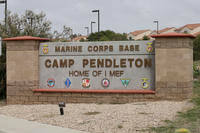KUNSAN AIR BASE, Republic of Korea -- When disaster strikes an Air Force base, whether a typhoon or an enemy attack, the mission must go on.
Emergency management specialists at Kunsan Air Base develop plans to make sure Airmen here will keep the mission going, no matter what happens.
"Keeping everyone trained and ready is extremely important," said Master Sgt. Jay Moreau, 8th Civil Engineer Squadron emergency management NCO in charge and installation emergency manager. "If the chemical threat from North Korea was to become a problem, training would prevent anyone from becoming an unnecessary victim."
Within just days of arriving at Kunsan, each new Wolf Pack member is issued both training and real-world chemical gear before undergoing base-specific training. The emergency managers stay busy making sure everyone is up to speed and knows all about chemical, biological, radiological and nuclear threats.
"In a stressful environment, training is what you fall back on," said Senior Airman John Gaylord, 8th CES emergency management journeyman. "It can be hard to think while wearing all that gear, so you'll perform better if you are comfortable with your training."
During exercises, they oversee the emergency management support teams (EMST) and shelter management teams (SMT). The EMSTs are responsible for checking liquid detection points in each chemical zone for contaminated M-8 paper. The SMTs process people entering secure facilities and contamination control areas.
For both real-world and exercise scenarios, the emergency managers use a large arsenal of technical equipment when responding. From joint chemical agent detectors which identify the type of contaminant to radiation level detectors, the equipment is vital in pinpointing the problem.
Since work must continue while wearing the bulky mission-oriented protective posture (MOPP) gear, figuring out quickly where the contaminants are is vital.
"Being aware of chemicals' locations and strength helps us determine how they will affect Airmen and the mission," said Moreau. "During a chemical attack, it's important for emergency management to quickly relay this information to base leadership so they can make decisions and respond to threats."
And the threats during Kunsan's nearly weeklong exercises are many. Almost nothing is simulated in the wing's scenarios, which are played out to the fullest extent.
"We simulate nothing so that we are testing the full extent of our capabilities during these exercises," said Moreau. "We practice how we would execute the mission in austere conditions. While we can't actually defend the base against a chemical, we can make sure people are trained to respond."




























